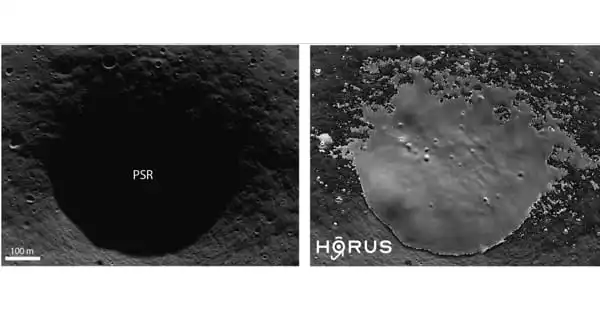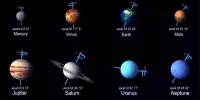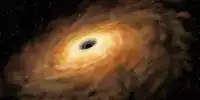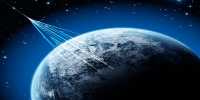Water ice is found in permanently shadowed lunar craters, but it is difficult to visualize. Sharper images are now provided via a machine learning technique. The polar regions of the Moon are home to craters and other depressions that never see sunlight. In the journal Nature Communications today, a group of researchers led by the Max Planck Institute for Solar System Research (MPS) in Germany provides the highest-resolution photos to yet spanning 17 such craters.
Craters of this type may contain frozen water, making them appealing targets for future lunar missions, and the researchers concentrated their efforts on relatively small and accessible craters surrounded by moderate slopes. In fact, three of the craters have been discovered to be inside the newly declared mission region of NASA’s Volatiles Investigating Polar Exploration Rover (VIPER), which is set to land on the Moon in 2023.
Imaging the interiors of permanently darkened craters is difficult, and previous studies relied on long exposure durations, which resulted in smearing and reduced resolution. Using reflected sunlight from neighboring hills and a novel image processing method, the researchers have now created images at 1-2 meters per pixel, which is at or very close to the cameras’ maximum capabilities.
The Moon is a harsh, arid desert. It lacks a protective atmosphere, unlike the Earth, and whatever water that existed during the Moon’s formation has long since evaporated under the effect of solar radiation and gone into space. Nonetheless, craters and depressions in the polar areas provide some grounds for optimism about restricted water resources. Scientists from MPS, the University of Oxford, and NASA’s Ames Research Center have now examined several of these locations in further detail.
Near the lunar north and south poles, incident sunlight enters craters and depressions at a very shallow angle and never reaches parts of their floors. Temperatures in some areas are so low during this “eternal night” that frozen water is projected to persist millions of years. It could have been transported by comets or asteroids, outgassed by volcanic eruptions, or generated by the interaction of the surface with the solar wind.
Dr. Valentin Bickel
“Near the lunar north and south poles, incident sunlight enters craters and depressions at a very shallow angle and never reaches parts of their floors,” reveals MPS-scientist Dr. Valentin Bickel, the paper’s first author. Temperatures in some areas are so low during this “eternal night” that frozen water is projected to persist millions of years. It could have been transported by comets or asteroids, outgassed by volcanic eruptions, or generated by the interaction of the surface with the solar wind.
Recent measurements of neutron flux and infrared radiation from space missions show the presence of water in these locations. NASA’s Lunar Crater Observation and Sensing Satellite (LCROSS) eventually supplied direct evidence: twelve years ago, the probe shot a bullet into the shadowed south pole crater Cabeus. The dust cloud released into space contained a significant amount of water, as later study revealed.
Permanently shaded locations, on the other hand, are not solely of scientific significance. If humans ever spend an extended period of time on the Moon, naturally occurring water would be a vital resource and shadowed craters and depressions will be a popular resort. In 2023, NASA’s unmanned VIPER rover, for example, will explore the South Pole region and visit similar craters. Images from space probes are essential for obtaining a precise picture of their terrain and geology in advance for mission planning considerations, for example. Since 2009, NASA’s Lunar Reconnaissance Orbiter (LRO) has provided similar photos.
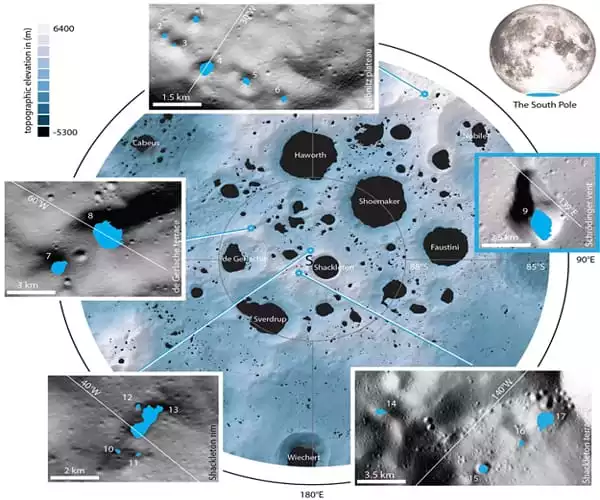
Capturing photographs within the deep darkness of permanently shaded locations, on the other hand, is exceedingly challenging; after all, the only sources of light are scattered light, such as that reflected off the Earth and surrounding topography, and dim starlight. “Because the spacecraft is in motion, the LRO photos are entirely blurred at lengthy exposure times,” explains co-author Ben Moseley of the University of Oxford. The spatial resolution is substantially better at short exposure durations. However, because of the limited amount of light available, these images are dominated by noise, making it difficult to detect true geological characteristics.
To solve this issue, the researchers created HORUS (Hyper-effective nOise Removal U-net Software), a machine learning method that “cleans up” such noisy images. It employs almost 70,000 LRO calibration photographs obtained on the dark side of the Moon, as well as camera temperature and the spacecraft’s trajectory, to determine which structures in the image are artifacts and which are real. The researchers will be able to obtain a resolution of roughly 1-2 meters per pixel, which is five to 10 times better than the resolution of all previously accessible photographs.
Using this strategy, the researchers re-evaluated photos of 17 shadowed patches from the lunar south pole region, ranging in size from 0.18 to 54 square kilometers. Small geological formations only a few meters broad can now be seen far more clearly than before in the generated photos. Boulders and very small craters are examples of these structures, which can be found all across the lunar surface. Because the Moon has no atmosphere, very small meteorites fall onto its surface on a regular basis, creating such mini-craters.
“With the help of the new HORUS photos, we can now comprehend the geology of lunar shadowed regions considerably better than before,” Moseley says. The quantity and shape of tiny craters, for example, reveal information on the age and composition of the surface. It also makes it easier to identify potential impediments and hazards for rovers or astronauts. A remarkably bright mini-crater was identified in one of the examined craters on the Leibnitz Plateau. “Its unusually vivid color may indicate that this crater is rather young,” adds Bickel. Because such a fresh wound allows relatively unimpeded access to deeper strata, the researchers believe this site could be an interesting target for future expeditions.
The latest photographs show no signs of frozen water on the surface, such as bright patches. “Some of the places we’ve targeted may be a little too warm,” speculates Bickel. It’s possible that lunar water doesn’t exist as a clearly visible deposit on the surface at all; instead, it might be mixed in with the regolith and dust, or it could be hidden underground.
The researchers’ next step is to use HORUS to analyze as many shaded places as possible in order to answer these and other concerns. “We intended to demonstrate the capabilities of our algorithm in this publication. Now we want to extend it as broadly as feasible” Bickel explains.
